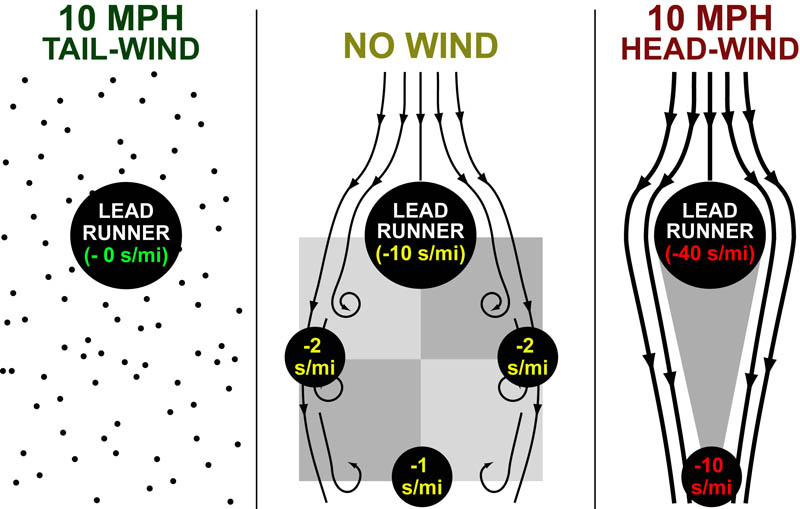Recently, while running a workout on a windy track, I started wondering about the science of air-resistance and drafting. More specifically, I wondered what difference was between 10 mph tail-wind and the 10mph head-wind I encountered on opposite sides of the track (see figure above). When I returned home, I discovered some classical papers that answered this exact question in an experimental and theoretical way (summarized in the Figure above).1-4
AIR RESISTANCE WHILE RUNNING:
To most clearly illustrate that main concepts, I have focused on one illustrative example of a runner moving at 6 min pace (or 10 mph) with either a 10 mph tail wind, no wind, or a 10 mph head wind (see figure above):
- 10mph tail wind = no air resistance: Here, relative to the runner, the air is not moving. This is because both the wind and the runner are moving at the exact same speed relative to the ground (10mph). These conditions are equivalent to running on a treadmill.
- no wind = 10 mph air resistance = ~10 seconds per mile penalty: Here, the wind is hitting the runner at 10mph. For an average competitive athlete I calculated a pace penalty of approximately ~10s/mi (though the exact conversion factor will vary).
- 10mph head-wind = 20 mph air resistance = ~40 seconds per mile penalty: Here, the wind is hitting the runner at 20 mph. You might be surprised that a doubling of air speed (10mph to 20mph) results in a quadrupling in pace-penalty (10s/mi to 40s/mi). This is because the “air-resistance force” is proportional to the “air velocity” squared (i.e. (2x)2 = 4x )
Overall, based on the figure above, you can see why a tail wind will never make up for a equal head wind. If you are running around a track with no wind your average pace penalty will be 10s/mi. If you are running around a track with a 10mph wind in one direction your average pace penalty will be 20s/mi = (0s/mi + 40s/mi)/2.
DRAFTING WHILE RUNNING:
In addition, the figure above also illustrates the wake that a runner leaves behind which other runners can take advantage of while racing. As you can see, the shape of the wake varies depending on the air-speed encountered:
- 10mph tail wind = no wake = drafting has no effect
- no wind = 1 meter x 1 meter square wake = drafting is effective at a wide range of angles behind runner. At this air-speed, the air creates vortices behind the runner (as a result of the slight vacuum created at the runners back) that expand the wake size. This effect is part of the reason birds often fly in triangle formations: so that the followers can ride the air vortices created by the leaders.
- 10mph head-wind = very narrow wake = drafting is only effective directly behind runner At relative air speeds >20mph the vortices behind the runner collapse resulting in a significant narrowing of the lead runners wake.
REFERENCES:
- Hill, A.V. The Air-Resistance to a Runner. Proceedings of the Royal Society of London. Series B 1927, 103, 380-385.
- Pugh, L.G.C.E. The influence of wind resistance in running and walking and the mechanical efficiency of work against horizontal or vertical forces. J. Physiol. 1971, 213, 255-276.
- Davies, C.T. Effects of wind assistance and resistance on the forward motion of a runner. J. App. Physiol. 1980, 48, 702-709.
- Noakes, T. Lore of Running 4th ed. 2001 Human Kinetics. Champaign, IL.

This work by Eugene Douglass and Chad Miller is licensed under a Creative Commons Attribution-NonCommercial-ShareAlike 3.0 Unported License.

